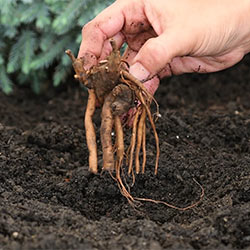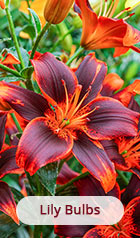Striking and versatile, the Clematis plant, with its climbing vines is an engaging addition to any landscape design. Easily trained to scale mailboxes, fenceposts, garden arbors and more, the combination of height, color and beauty creates a dynamic garden display wherever it is placed. Bearing a multitude of blooms, it is a delightful sun loving perennial that adds so much to the late-spring and summertime landscape. Available in a bevy of colors, sizes and forms, each Clematis flower boasts its own unique look and charm, and can be arranged in the garden in a variety of interesting ways.
Questions about Clematis Plants
What types of flowers bloom from clematis plants?
Clematis vines produce a variety of different flowers depending on the species of clematis you choose. For example,
Clematis Little Lemons produces small citrus-colored bell-shaped flowers in a nodding form. Striking
Taiga Clematis opens with large, ruffled flowers in multiple layers and an eye-catching purple color.
Clematis Beautiful Bride. features a large, classic, disc-shaped flower of pure white with pretty eye-catching centers. In short-the clematis genus is truly varied! Most clematis are easily identified thanks to their delicate, twining stems and attractive rich green foliage.
Where is the best place to plant clematis?
Clematis plants thrive in Zones 4-9. If you're not sure what zone you're in, find out using our
Zone Finder tool. Clematis grow well in full-sun locations, and many varieties will perform nicely in containers. Give your Clematis plants at least six hours of sunlight per day for the best performance.
When your plants arrive and you are ready to plant, choose a location in your garden that provides full sun to partial shade for your clematis vines. Plant your clematis a few inches deep, so the stem and bottom most nodes or leaf sets are covered a mixture of soil and compost. Leave a little space in your dug hole to fill with soil and water, and then cover with mulch. For more tips on planting Clematis, read our
guide.
Do clematis vines need to be pruned?
Knowing whether to prune clematis plants can be a bit tricky! Clematis vines do need to be pruned back, but pruning requirements will be specific to each species of clematis plant. Some clematis plants bloom on last year's growth and some bloom on growth from the current season. Plants that bloom on the previous season's vines need very selective pruning-you don't want to cut off the buds for this year's flowers. Clematis that bloom on new growth can be pruned much more freely. Check the instructions available for each of your clematis vines.
What kind of winter care do clematis vines need?
Before winter begins, clematis should be pruned back according to their species' requirements. As soon as the ground freezes, pile a generous 2-3 inch layer of mulch around the base of the clematis plant. You'll cease watering during winter, and begin again when the plant begins to green in springtime.
Will clematis come back every year?
Clematis plants are perennials, and they do come back year after year if given the proper care. Keep in mind that most clematis plants are hardy in zones about as cold as Zone 4. Prune your clematis plants appropriately-check the instructions for each variety of clematis, as some need more pruning than others-and provide them with a good layer of mulch to insulate the plants throughout the winter.






















